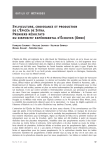Download Planning for Landscape Change: An Introduction and User's Guide
Transcript
Planning for Landscape Change: An Introduction and User’s Guide to Supplementary Planning Guidance to the Staffordshire and Stoke on Trent Structure Plan, 1996 – 2011 Planning for Landscape Change: Supplementary Planning Guidance to the Staffordshire and Stoke on Trent Structure Plan, 1996 – 2011 Volume 1: An Introduction and User’s Guide Staffordshire County Council, Development Services Department, 2000 Adopted on 10 May 2001 as Supplementary Planning Guidance to the Staffordshire and Stoke-on-Trent Structure Plan 1996-2011 Contents Page Introduction 1 Landscape and landscape change 3 A strategy based on landscape character 4 Assessing compliance with Structure Plan Policy NC2 6 Detailed landscape descriptions 10 Map 1: Landscape policy objectives Opposite 6 Map 2: A Parish-based landscape map Opposite 14 Introduction Planning for Landscape Change is aimed primarily at planning officers in the Staffordshire and Stoke-on-Trent Structure Plan area, and at developers and others who need to be informed about policy and practice for the conservation, enhancement and regeneration of the rural landscapes of the Plan area. It may also prove to be of value in a wider context, as a means of informing other decisions relating to land use and land management. The full Supplementary Planning comprises: h this Introduction and User’s Guide (Vol. 1); h an explanation of the method used to generate the maps and landscape descriptions that follow (Vol. 2); h a map showing the distribution of a number of distinct types of landscape that are found within the Structure Plan area (Appendix 1); h a series of detailed descriptions of the character of those landscapes (Vol. 3); h a map showing the areas to which landscape policy objectives, described below, apply (Appendix 1); h an appendix (Vol. 2) indicating the areas that are preferred for targeting resources for woodland initiatives, including new planting and management. Planning for Landscape Change draws on government guidance on development plan policies for the conservation and enhancement of landscape character and quality, and on work undertaken by the former Countryside Commission and English Nature to map and describe the landscape character of England. It has been published having regard to the views of the Panel appointed to conduct an Examination in Public of the Staffordshire and Stoke on Trent Structure Plan 1996 – 2011. The Panel’s report, published in December 1999 stated that: “…it seems inevitable to us that a substantial amount of information needs to be published by SCC [Staffordshire County Council] to explain the meaning of the defined landscape policy areas. What this documentation is called seems secondary to its importance in raising awareness of the approach. However, we see every advantage in it being subject to a full consultation exercise and then being adopted as SPG [Supplementary Planning Guidance].” That consultation exercise was carried out during the autumn of 2000, and this adopted Guidance incorporates changes made as a result of representations. However, some comments on the details of the landscape descriptions in Volume 3 will only become available after the Guidance has been in use for some time. To take account of this, the County Council invites such comments from users, and will incorporate any further changes, based on them, in a revised version of this Guidance to be published in due course. Any such comments should be addressed to the Corporate Director (Development Services), Staffordshire County Council, Riverway, Stafford ST16 3TJ, for the attention of Steve Potter, Head of Environmental Planning. 1 The Guidance supplements Policy NC2 of the Staffordshire and Stoke on Trent Structure Plan, 1996 – 2011, which states: Landscape protection and restoration Development should be informed by and be sympathetic to landscape character and quality and should contribute, as appropriate, to the regeneration, restoration, enhancement, maintenance or active conservation of the landscape likely to be affected. Proposals with landscape and visual implications will be assessed having regard to the extent to which they would: (a) cause unacceptable visual harm; (b) introduce (or conversely remove) incongruous landscape elements; (c) cause the disturbance or loss of (or conversely help to maintain): (i) landscape elements that contribute to local distinctiveness; (ii) historic elements which contribute significantly to landscape character and quality, such as field, settlement or road patterns; (iii) semi-natural vegetation which is characteristic of that landscape type; (iv) the visual condition of landscape elements; (v) tranquillity. 2 Landscapes and landscape change 1.1 The modern countryside has come about through a long process of interaction between people and the basic elements of the land: the rocks and soils, the hills, slopes and valleys, the streams and rivers that drain them, and the plants and animals that are native to the area, or that have been introduced to it. Physical influences such as geology and landform are often the key determinants of landscape character, but in places the overlying pattern of settlement, land use, or field enclosure may be more significant. Human influences are evident not only in the presence of physical features such as hedgerows and buildings, but also in the way in which the land has been owned and managed. The resulting landscapes are neither wholly natural, nor are they entirely man-made artefacts. 1.2 Changes in soils or a boundary between rock types still influence cropping patterns and the distribution of wild plants, despite centuries of farming; variations in social structures which came about before the Middle Ages, and more recently, have left their legacy in the distribution and arrangement of villages and settlements. The dialogue between people and the land has been long and constantly changing, but always within the limits set by these elements. This effect has given rise to a particular distinctiveness - a sense of identity - in each part of the county. Kinver and its environs are very different from Leek and the Moorlands for very good reasons, which inform and define the experience of place. 1.3 Because our landscapes result in part from human activities they have been in a constant state of change, and will continue so. Attempts to preserve them unchanged into the future are generally misguided and bound to fail. The increasing pace and scale of change, however, has become a major cause for concern and there are many who feel that much of what is valued is in danger of being lost, while much of what is new is bland, insensitive and lacking in character. There is a danger that modern technological processes will unwittingly erode local distinctiveness and the quality associated with the experience of place, because they need not be constrained by the limitations previously imposed by the rocks and soils and patterns of settlement: a danger that the special qualities resulting from the historic dialogue will be drowned out by the visual equivalent of noise. 1.4 With growing evidence that present day processes of change often degrade rather than strengthen the character of the countryside, there is an urgent need to find effective mechanisms for reversing this trend. This does not mean that we need to go backwards to some rural idyll, even if this were possible, but if we are serious about conserving the character of the countryside we need to find ways to retain pattern and diversity in landscape. The challenge that we are faced with is to find new ways of accommodating change, whilst maintaining that link with the past which helps to give us a sense of belonging. Maintaining this link will require a commitment not only to manage the countryside, but also to guide and control the forces for change. 3 A strategy based on landscape character 2.1 In the mid-1990s the former Countryside Commission recognised the need to build on a developing trend of looking wider in its strategic thinking than the areas of landscape with special qualities, such as National Parks and Areas of Outstanding Natural Beauty, which it had originally been charged with protecting. It needed to develop policies for the whole countryside, and as a basis for that process it needed a consistent analysis of the character of the landscapes of England. As no such analysis existed it commissioned, in partnership with English Nature and with help from English Heritage, a project that came to be called the Character of England project. The first output was a map which divides England into 181 discrete Regional Character Areas (RCAs) based on the interaction at a regional scale between the physiographic elements of landscapes and the patterns of land use and settlement characteristic of them. Written summaries of the character of each of these areas were also published. Some of the Character Areas are already familiar because of their distinctiveness, e.g. Dartmoor, the Cotswolds, the Dark Peak and the White Peak, but others including some in Staffordshire are less familiar because their character is subtle and less easily defined. Nine Character Areas fall wholly or partly within the Staffordshire and Stoke on Trent Structure Plan Area. 2.2 A process of decision making that builds on this work, and is based on an understanding of landscape character and of the natural, historic and aesthetic factors that in combination create local distinctiveness, has come to be known as the character approach. It stands in contrast to the more traditional approach, which sought to identify those landscapes of the greatest scenic value or natural beauty, and to apply more restrictive planning policies within them, as a means of protecting their special qualities. At the national level this has led to the statutory designation of National Parks and Areas of Outstanding Natural Beauty, and locally to non-statutory designation, in development plans, of landscapes termed variously as Special Landscape Areas, Areas of Great Landscape Value, etc. The Staffordshire Structure Plan, 1986 – 2001 and the Local Plans building on it contained policies for the protection of Special Landscape Areas. 2.3 Planning Policy Guidance note 7, The Countryside - Environmental Quality and Economic and Social Development (published by the Department of the Environment in 1997), requires a fundamental reassessment of local countryside designations. The guidance indicates that designations should only be maintained or extended where there is good reason to believe that normal planning policies cannot provide the necessary protection. It also commends the character approach, which ‘identifies the unique character of different areas of the countryside without making judgements about their relative worth’ as a means of accommodating change without sacrificing landscape character. But how is an understanding of local character and distinctiveness to be acquired and propagated? Will every planning officer and developer have to be trained in techniques of landscape assessment, to enable them to analyse local character on a case-by-case basis? The Countryside Agency’s Countryside Character volume for the West Midlands, published in July 1999, is helpful in this respect, but it describes character at a regional level, using mapping units that average about 280 square miles in area. It is very difficult to use this broad-brush information as a means of informing planning decisions. 2.4 To overcome this difficulty the analysis of landscape character in the Structure Plan area has been taken to a more detailed level, through a comprehensive assessment of landscape character. The boundaries of the Character Areas which were broadly delineated on the Character of England map have been more precisely defined, and 4 the descriptions of landscape character have been taken to a finer grain, with the mapping and description of 22 landscape character types (LCTs). These descriptions make up the greater part of the Supplementary Planning Guidance to the Structure Plan. 2.5 No judgements about the relative worth of such landscape types have been made, but the approach does acknowledge that any given landscape type will be represented by some areas in which the underlying landscape character is strongly expressed and the constituent elements are in good condition, and other areas where this is not the case. Landscape quality can be defined in these terms: it is quite distinct from scenic beauty, but it is strongly linked to character. It is essentially an indicator of how clearly that character is expressed, and of how the state of repair of landscape elements contributes to an overall impression of an intact and unified landscape. Landscape quality can be assessed with respect to the following factors: i) the presence or absence of landscape elements which have had some permanence over time, and which are characteristic features of that landscape type; ii) the presence or absence of relatively novel features which are incongruous in that landscape type; iii) the condition of landscape features, and the likelihood of their continuing survival as functional landscape elements; iv) the extent to which the landscape exhibits a clear and consistent pattern of components resulting from a particular course of historical development; v) the continuity or ‘time depth’ of the landscape, which is a function of the length of time since the last major change of land use that contributed significantly to current landscape character; vi) the extent of survival of semi-natural habitat that is characteristic of the landscape type. 2.6 The assessment of landscape quality, as defined above, has led to the mapping of landscape policy objective zones (Map 1). Those areas of the highest quality fall within the zones in which ‘active landscape conservation’ is the objective, and those of the lowest quality in the ‘innovative landscape regeneration’ zones. See the box on page 8 for more details. 2.7 These factors also contribute to landscape sensitivity, along with the landscape’s general visibility and its tranquillity, which is a function of its isolation from factors contributing to visual or noise intrusion. The landscapes which are most sensitive to the impacts of development or land use change may justify more restrictive Local Plan development control policies than those of lower sensitivity. 5 Assessing compliance with Structure Plan Policy NC2 3.1 The Staffordshire and Stoke on Trent Structure Plan, 1996 – 2011, has adopted the ‘character approach’ to landscape protection and restoration, and consequently it makes no reference to local designations such as Special Landscape Areas. Instead, it requires that development should satisfy a number of tests, laid out in Policy NC2, to demonstrate that it is acceptable in terms of its landscape and visual impact. The policy must, of course, be interpreted in the context of all others, including those for the protection of Green Belt, and of ‘best and most versatile’ agricultural land. 3.2 The tests laid out in Policy NC2 are as follows: 1) Are the development proposals adequately informed by an understanding of the landscape character of the area within which the development would be sited? Has the applicant made reference to Planning for Landscape Change, or to the relevant section of the Countryside Agency publication Countryside Character, Volume 5: West Midlands, or has an adequate independent landscape character assessment been carried out? 2) Is there evidence that the proposal has taken account of local landscape character, e.g. in the choice of building materials and in the design, siting and scale of the development? 3) Will the proposed development contribute to the appropriate landscape policy objective for the area? This can be determined by reference to Map 1. In any landscape there will be a need to conserve some features, to restore some, and possibly to replace others, in order to maintain or improve landscape quality, but one of these themes will predominate. Thus, conservation is most important in areas where the landscape features are in good condition and its character is strongly expressed, and regeneration is the predominant theme where character has been severely eroded and landscape features are in poor condition. See the box, below, for more details. 4) To what extent would the proposed development be visually intrusive? The general visibility of each landscape, as determined by its landform and its tree and woodland cover, has been mapped (see Appendix 1 of the Supporting Documentation), and this contributes in part to the assessment of landscape sensitivity. However, this question has to be addressed site-specifically. 5) To what extent will the proposed development lead to the introduction of features that are incongruous to the landscape in question, or are there proposals for the removal of such features? Examples of incongruous features are given in the detailed descriptions of landscape types. In this respect development could have a positive impact, e.g. by removing industrial dereliction, or a negative impact, e.g. by introducing overhead power lines to a rural farming landscape previously devoid of them. 6 6) Will the proposed development have an adverse impact on the evidence of human interaction with the landscape over time, and to what extent? Such evidence includes the pattern of settlement, from dispersed farmsteads to nucleated villages; the pattern of field enclosure; agricultural artefacts, such as ridge and furrow; the distribution of woodland and trees, and the road and track pattern. Development can only rarely have a positive impact over the short term in this respect, but good design can minimise its negative impact. 7) Will the proposed development lead to the loss of semi-natural vegetation that is characteristic of this type of landscape, or will it provide opportunities for its conservation, restoration or reintroduction? The emphasis should be on such vegetation being characteristic: there is little or no value, e.g. in attempting to create heathland in a landscape that has not contained it historically. To do so could undermine landscape character, rather than reinforcing it. 8) To what extent will the proposed development affect other characteristic landscape features, and will the impact be positive, e.g. by conserving features that are otherwise at risk, or negative, by removing them? The features characteristic of each landscape type are listed in their detailed descriptions. 9) Will the proposed development have any impact on the visual condition of all of the elements that combine to give the landscape its distinctive character, and will that impact be positive or negative? As an example, development adjacent to previously unmanaged woodland, and dependent on it for screening, could lead to the implementation of a management plan for it, and this could improve both its visual condition (e.g. by the replanting of windblown areas) and its likelihood of long-term survival. 10) Will the proposed development have any impact on the tranquillity of the area? Tranquil areas are those that are sufficiently remote from the visual or noise intrusion of development or traffic to be considered unspoilt by urban influences. They are mapped in Appendix 1. Within tranquil or semi-tranquil areas there is a risk that built development or increased road traffic associated with it will have a negative impact on their tranquillity. 7 Meeting landscape policy objectives In areas for which the objective is landscape maintenance substantial emphasis should be placed on ensuring that the development blends unobtrusively into the landscape and does not lead to the loss of features characteristic of it. Where the objective is active landscape conservation the same requirements apply, but in addition any development should make a positive contribution, e.g. through the restoration or management of characteristic features such as buildings, parkland or woodland. Areas of somewhat lower landscape quality have as their objective landscape enhancement. These areas have suffered some erosion of strength of character and loss of condition of landscape elements. There is a particular need to encourage relatively small-scale landscape conservation schemes such as hedgerow maintenance, habitat creation and tree and woodland planting, to stem the decline in landscape quality that will otherwise become more evident. Where landscape restoration has been identified as the appropriate objective many of the features previously characteristic of the landscape type will have been lost. The emphasis is therefore on the re-creation of character through the provision of new features that are not necessarily a slavish copy of those that have been lost, but which draw inspiration from them. As an example, many of the areas falling within this category are within the former coalfields, which had a characteristic pattern of small fields. That pattern is now almost completely lost in many places and it would not be practicable to try to recreate it, for economic reasons. However, the planting of small woodlands through e.g. the Forest of Mercia project will help to re-create the sense of enclosure and the reduction in scale of the landscape previously provided by the field pattern. In some areas the loss of the characteristic features and patterns of the landscape is so complete that restoration is not possible, and replacement landscapes of a new character are required. This is particularly the case where the reclamation of formerly derelict land has resulted in engineered landforms, or where past development has resulted in major new landscape features. An example is the winning of sand and gravel in the Tame and Trent Valleys, between Tamworth and Burton upon Trent. This is resulting in an extensive chain of new lakes which are not characteristic of the former valley floodplain, but which have the potential to create a new landscape of great character. 8 3.3 A matrix, such as that illustrated below, may be a helpful means of summarising the assessment of the likely impact of a proposed development on landscape character. Landscape policy objective appropriate to the area: Impact with respect to: Incongruous landscape elements Historic landscape elements Characteristic seminatural vegetation: Other landscape elements adding to distinctiveness: Visual condition of landscape elements: Tranquillity: Nature and strength of the impact Strongly Negative Neutral Positive Strongly negative positive Visual impact: Overall contribution to the landscape policy objective: 3.4 The detailed tests laid out in Policy NC2, and based on the factors listed above, are intended to provide a means of assessing the impact of development or other change of land use on landscape character and condition. The mapping of landscape quality provides a means of identifying the appropriate landscape policy objective for each area, and the assessment of landscape sensitivity should assist in indicating how easy it will be to mitigate the impacts of development or land use change. Taken together, the maps and the detailed landscape character descriptions will help in determining to what extent a particular development or change of use is appropriate to the landscape in question. 3.5 It should be noted that the mapping units used throughout the guidance have boundaries which have generally been drawn to follow a recognisable feature on the ground, but in appreciating landscape character our perception does not stop at such boundaries. The character of any particular area will be influenced visually by that of surrounding areas. Decisions relating to the location and nature of development should be informed by all of the relevant material in this guidance, and it will sometimes be necessary to refer to two or more landscape character descriptions, and to consider the landscape policy objectives for surrounding land. 9 Detailed landscape descriptions 4.1 The full Supplementary Planning Guidance contains detailed descriptions of all of the 22 landscape character types and six sub-types that occur in the nine Regional Character Areas found within the Structure Plan area. This requires about 250 pages of text. For many purposes it will be sufficient to select the information relating to the area in question, and such customised versions of the Guidance can be prepared on request. As an example of this facility the relevant information for a single parish - Brown Edge, in the Staffordshire Moorlands - follows. 4.2 Brown Edge falls within the Potteries and Churnet Valley Regional Character area, and this is described first, to provide a regional landscape context. This is followed by descriptions of the two landscape character types found within the parish, i.e. ancient slope and valley farmlands and gritstone uplands. The map shows the general distribution of these landscape types, and the landscape policy objectives that are considered relevant. 10 Potteries and Churnet Valley 1. This Regional Character Area, which is contained almost wholly within the county boundary, marks a zone of transition between lowlands and uplands, in the elevation range from about 100m to 300m O.D. The central part comprises heavily dissected hills and the extensively wooded valley of the River Churnet, associated with Carboniferous and Permo-Triassic sandstones, overlain in the main by brown earths and podzols. To the north west, towards Biddulph Moor and Mow Cop, outlying gritstone outcrops with stagnogleys and peat soils give rise to deeply incised plateaux of moorland and upland grassland. Carboniferous coal measures, covered in glacial drift and with stagnogley soils, underlie the fringes of Stoke-on-Trent. 2. Traces of early colonisation of the area survive chiefly in the form of barrows on high ground. The remains of an Iron Age hillfort survive within Alton Towers. A Roman road, from Littlechester to Chesterton, passed through the area, although evidence of occupation during that period is sparse. A diverse medieval landscape developed, with substantial surviving woodland in the south, thinning out to the north. Much of the economy of the area was pastoral, with arable cultivation close to settlements. Fields were enclosed, by private treaty, in the early post medieval period. 3. The industrial revolution had a significant effect on the area. A tendency towards specialised pastoral farming may have been the result of increased markets in the growing Potteries, which were founded on the winning of high quality clays. The area would also have produced cattle for fattening on more fertile pastures to the south. The processing of ferrous and non-ferrous metals was important in and around the Churnet Valley which, despite its attractive woodland setting, is still littered with the spoil heaps and industrial buildings of the eighteenth and nineteenth centuries. The area is also crisscrossed by canals, tram roads and railways, many long abandoned. Plentiful water supplies gave rise to mills, which then became surrounded by tiny industrial hamlets, many of which (e.g. Oakamoor and Tean) survive. Large areas remained unenclosed until the Georgian period, and Parliamentary Enclosure landscapes are a feature of the upland areas away from the mills and mines of the valleys. 4. The North Staffordshire Coalfield occupies much of the western part of the area, where deep mining, opencasting and clay winning have had a considerable impact on the landscapes of the area around Silverdale. There is a small outlier to the coalfield near Cheadle. Other industries have included lead and ironstone mining, glass making and stone quarrying. 5. Although a large part of the west of this region is occupied by the expanded Pottery towns, the character of its buildings can still be discerned in the north and east. Here the gritstone buildings of villages and farmsteads have an almost defensive appearance clustered together in the short, steep wooded stream valleys known locally as cloughs. Buildings in Ipstones to the east illustrate the solid stone proportions used and these can be seen repeated where brick and tile have been introduced. Many of the large seventeenthcentury houses, such as Horton Hall and Belmont Hall, adopted forms such as stone-mullioned windows with hood moulds, which are seen at their grandest at Caverswall Castle. These continued to be used, for instance in unpretentious farmhouses like Gillowfold Farm near Biddulph, into the eighteenth century. The nineteenth century prosperity of Stoke-on-Trent saw 11 the creation of a number of landscaped parks and gardens, many of which survive. At Alton the famous pleasure gardens were designed to fill a rocky dell and in the village itself Alton Castle looks down on the Churnet like a castle on the Rhine. The recently restored Victorian gardens of Biddulph Grange are also a notable visitor attraction. 6. The agricultural land quality is generally poor, with approximately two thirds of the land Grade 4 and one third Grade 3. About two thirds of the holdings qualify as part time by MAFF criteria, although it is likely that a significant number are run as full time units, particularly in the north, with some consequent hidden underemployment. Three quarters of the area is permanent pasture, reflecting the below average land quality. This is predominantly a dairying area, but it also has substantial numbers of beef and sheep enterprises. There is some horticultural activity but this is almost entirely hardy nursery stock production. In the south there is a small area of arable cropping, mainly of cereals. 7. The greatest concentration of woodland in the area is the Churnet Valley, where there are large Forest Enterprise leaseholds, other commercial coniferous woodlands (mainly of Corsican pine) managed by private forestry companies, and wooded nature reserves owned by conservation organisations, and by the County Council. There is a particularly impressive concentration of ancient semi-natural woodland here, and the valley as a whole is a very good example of the constructive co-existence of commercial forestry, recreation provision and nature conservation in an area that can lay claim to being one of the birth places of the industrial revolution. 8. The valley runs through a smoothly undulating upland pastoral landscape, linking to it by cloughs. Above these, stone walls become more common and narrow winding lanes and stone farmhouses give a consistent upland feel, with extensive long distance views. Sessile oak (Quercus petraea) is a characteristic species of the Churnet Valley and the cloughs, and sycamore (Acer pseudoplatanus) is common around farm buildings. There is some visual evidence of a decline in farming fortunes here. 9. A similar decline is evident in the area fringing the Stoke-on-Trent/Newcastle conurbation. There, on an undulating plateau, a very high density but dispersed pattern of farmsteads and individual properties is characteristic, with small to medium sized hedged fields used predominantly for stock raising. The area is sparsely wooded, and it has an urbanised pattern of many old mining villages. The effects of former and more recent coal mining activity are numerous in their impact on this landscape. 10. The recent development and expansion of Stoke-on-Trent has tended to obscure the evidence that it was originally a series of upland settlements. That character reasserts itself strongly to the north, around Biddulph Moor and Mow Cop, where stock rearing and rough grazing is practised in a regular pattern of medium to large-scale fields. The field name of hollins, found commonly here, probably relates to former holly (Ilex aquifolium) plantations, established to provide winter browse for livestock. Ancient woodland is well represented and along the border with Cheshire wooded cloughs are a distinctive feature of the landscape. The lower-lying marshy areas are a stronghold for the distribution of bay willow (Salix pentandra). 12 11. In the coalfield farmlands to the south of Stoke-on-Trent the landscape has very much more of a lowland character, with intact field patterns, well trimmed hedges, numerous large hedgerow oaks and a well cared-for feel. 12. This part of the county is given its character by its pronounced landform, with deeply incised steep valley sides and extensive woodlands, and by its proximity and visual links to the adjacent Peak District. The presence of a large industrial conurbation has a pronounced effect on many of the landscapes surrounding it, with dense settlement patterns and well used roads. It is an area, however, with many attractions stemming from its scenic quality and industrial past. 13 Ancient slope and valley farmlands This upland landscape type is restricted to the north of the county, on the coal measures and millstone grit. There are influences from early mining activity, but they are less pronounced than in the coalfield farmlands. The topography is varied but always undulating and often steeply sloping. Some acidic grassland and wet heath survives on the non-calcareous stagnogley soils, but dairying and stock rearing predominate in small hedged fields of an irregular pattern. Small woodlands, often of ancient origin, are well represented. The settlement pattern is dispersed and rather dense. Visual character This is a strongly undulating or sloping landscape interrupted by localised smaller scale steep sided stream valleys. These provide a range of scales from small and intimate in the valley bottoms to the larger scale, with extensive views offered from the higher ground. The generally intact ancient field pattern, hedgerow trees, and ribbons of broadleaved woodland running up side valleys are all subordinate to the strong effects of localised landform, but they provide important structure to the landscape. The woodlands, both broadleaved and coniferous in nature, have a strong visual influence on the landscape as a result of their interlock and relative position on the surrounding higher ground. The field pattern, predominantly irregular but with some geometrically planned areas, is deteriorating in places. There is some hedgerow removal, some general decline until only overgrown individual thorns remain, and some areas in which hedges are well trimmed but gappy, with extensive fencing. The size of fields varies from small to medium scale, with low intensity pastoral sheep and cattle farming predominating. Hedgerow trees of ash, oak and sycamore are never numerous enough to interrupt views through this enclosed landscape. Settlement reflects its ancient character, with narrow winding lanes, often sunken in nature, linking small farms. Halls and associated parkland impart their particular character on specific areas. Throughout the area, the high population density in the form of scattered farms, spreading nearby settlements and early mining activities, increases the urbanised nature of this landscape. On the edge of the conurbation there are a number of detractors, such as old industrial developments linked with a canal, areas of old housing and factories, together with later developments such as ribbon housing development and sewage works. In upland areas nearer to the moorland edge, field boundaries are of drystone walls giving a smoother, more cared for appearance to the landscape. In these areas, buildings are more generally of local stone and associated with groups of sycamore, giving a particularly strong local character. Characteristic landscape features Strong ridge and valley landform; small dissected stream valleys; small sunken lanes; low intensity pasture farming; intact hedgerow pattern; drystone walls and stone buildings; hedgerow trees; broadleaved valley woodlands; conifer plantations; many isolated properties. 14 Incongruous landscape features Expanding urban edge; fencing; present and past quarrying and mining activities; busy roads; power lines; localised industrial and residential expansion. Factors critical to landscape character and quality The critical factors which currently limit landscape quality are a decline in the condition of some of the characteristic landscape features, a proliferation of the incongruous features as listed above, and the loss of some of the semi-natural vegetation characteristic of this landscape type (i.e. ancient woodland and hedgerows, semi-natural grasslands and wet heathland). Potential value of new woodland planting. Generally of high value, to reinforce the unifying effect of woodland on a landscape in which the urbanising elements and isolated settlements will become visually subservient or screened; to provide urban tree planting and a woodland setting to residential and industrial expansion; as a major component of sand and gravel quarry restoration and screening; to mitigate the visual impact of earlier unsympathetic conifer plantations by modifying them following current forestry design guidelines; to restore the landcover structure of the landscape following gradual decline due to lack of maintenance of the hedgerow pattern; to reduce the effects of fragmentation and isolation of ancient woodland through the strategic siting of new native woodland. Significant parts of the areas falling within this landscape type are also within the boundary of a Community Woodland Zone as defined in the Newcastle under Lyme Local Plan. Within these areas the Borough Council will encourage the establishment of new woodlands with similar objectives to those of Community Forest Areas, albeit on a smaller scale. Potential value of other habitat provision and management The following Staffordshire Biodiversity Action Plan Targets are relevant at landscape scale: Habitat type Objective or target Priority Ancient/ semi-natural broadleaved woodland maintain and enhance restore degraded sites recreate/ regenerate maintain and manage maintain trees plant species-rich hedges maintain, improve and restore maintain and enhance water bodies and catchments increase the number of such features very high medium medium high high medium lower high Ancient/ diverse hedgerows Hedgerows Arable field margins Canals, lakes and ponds 15 medium Habitat type Objective or target Priority Lowland acidic grassland maintain, enhance, restore and buffer prevent further losses (except to heathland restoration) increase the number of such sites link fragmented sites through habitat creation protect existing heaths from development and damaging activities re-create or create new heathlands maintain and enhance restore former raised bogs maintain and create maintain and improve the quality and quantity of water maintain the quality of all natural existing channel features maintain and safeguard existing areas restore link adjacent sites through habitat creation create/ re-create new areas maintain, enhance and restore prevent further loss increase the number of such woodlands high medium Lowland heathland Peat bogs Reedbeds Rivers and streams Unimproved neutral grassland Wet woodland medium lower very high very high high high medium high high medium high medium lower lower lower lower Further details of these habitat targets can be found in the Staffordshire Biodiversity Action Plan. Specific guidelines Tree and woodland planting Woodland planting of a small to medium scale is generally appropriate in this landscape, from field corner to field size, tying into the existing woodlands and hedgerows with attention to edge detail and predominantly of a broadleaved character. Because of the steeply sloping nature of the valley sides, the woodlands need also to respond to landform as appropriate and care needs to be taken over the internal design of species blocks, although some conifer content is appropriate. The scale of woodland planting needs to reflect its position within the landscape, with smallscale tree planting schemes more appropriate in the valley bottoms, increasing in scale up the slope. Planting should be kept away from popular viewpoints and the interlock between planting and open areas retained to respect views through the area. ‘Stepping stone’ plantations, sited to reduce the isolation of existing ancient woodlands, should comprise locally native species. 16 Gritstone uplands This is a landscape type of the Dark Peak, which has only marginal representation at the highest elevations of the Structure Plan area. There are two variants of this landscape type: highland fringe, found at the highest elevations, and uplands, as here, at the lower elevation limit. The Palaeozoic sandstones, or millstone grit, form a deeply dissected plateau with stagnogleys and peat soils which support upland grassland and some small patches of remnant moorland. The predominant land use is stock rearing, in medium to large sized walled fields of a regular pattern; there are few woodlands other than on the steep sides of cloughs. Settlement comprises mainly farmsteads in a dispersed pattern at low density, although some expanded hamlets exert an urban fringe influence. Visual character This is an upland landscape with strongly undulating slopes, and many localised steep sided valleys rising to an upland plateau of generally open bleak character. The landform provides a range of scales from the small intimate scale of valley bottoms to a medium scale with extensive views offered from the higher ground. The farmland is characterised by an apparent decline in farming fortunes, resulting in deteriorating and shabby hedgerows of individual overgrown thorn trees and universal fencing, with only the occasional well maintained hedgerow. Trees, particularly beech, ash and sycamore, are predominantly associated with individual buildings. In places field boundaries are of deteriorating drystone walls. The size of fields varies from small to medium in different parts of the landscape with low intensity pastoral sheep and cattle farming predominating. Small streams and their associated linear woodlands provide an important structural element to the landscape. The landscape has a strong upland but urbanised character particular to its position between the conurbation and the upland, and reflecting historical land uses. The high population density in the form of numerous scattered farms, spreading nearby settlements and improved individual properties increases the urban nature of the landscape, with its upland feel reinforced by the use of stone as a building material and uninterrupted views out to adjacent moorlands. Settlements are linked by a considerable network of small, steep, sunken winding lanes. Characteristic landscape features Upland ridge landform with small steep side valleys; extensive areas of broadleaved woodland; small steep sunken lanes; gritstone walls and stone dwellings; pasture farming; hedgerows and hedgerow trees; extensive views; large farms; many individual residential properties. Incongruous landscape features Introduction of fencing for stock control. Large farm buildings. Inappropriate urbanisation of commuter dwellings. 17 Factors critical to landscape character and quality The critical factors which currently limit landscape quality are the relatively poor survival of characteristic semi-natural vegetation (i.e. ancient woodland, heathland and semi-natural grasslands) and, to a slightly lesser extent, the loss of characteristic landscape features and the poor condition of those that remain. Potential value of new woodland planting. Very high, to restore a landcover structure to those areas showing the effects of hedgerow decline; to provide a unifying feature in the landscape to accommodate urban growth and screen its visual consequences. The strategic siting of new native woodland could be of great value in reducing the effects of fragmentation and isolation of ancient woodland. Potential value of other habitat provision and management The following Staffordshire Biodiversity Action Plan Targets are relevant at landscape scale: Habitat type Ancient/ semi-natural broadleaved woodland Ancient/ diverse hedgerows Hedgerows Arable field margins Canals, lakes and ponds Acidic grassland Heathland Reedbeds Rivers and streams Objective or target maintain and enhance restore degraded sites recreate/ regenerate maintain and manage maintain trees plant species-rich hedges maintain, improve and restore maintain and enhance water bodies and catchments increase the number of such features maintain, enhance, restore and buffer prevent further losses (except to heathland restoration) increase the number of such sites link fragmented sites through habitat creation protect existing heaths from development and damaging activities re-create or create new heathlands maintain and create maintain and improve the quality and quantity of water maintain the quality of all natural existing channel features 18 Priority high high high medium medium high medium medium lower high high high high high high medium medium High Habitat type Unimproved neutral grassland Objective or target maintain and safeguard existing areas restore link adjacent sites through habitat creation create/ re-create new areas Priority very high high very high very high Further details of these habitat targets can be found in the Staffordshire Biodiversity Action Plan. Specific guidelines Tree and woodland planting A range of scales of planting is appropriate to reflect location, with small scale planting appropriate in the valley bottoms and increasing in scale up the hillsides to large scale planting on the upper slopes. Detailed design of woodlands needs to take account of edge treatments to tie into existing woodlands and field pattern. The shape should respond to landform and care is needed over the shape of lower edges and the effect on the ridge skyline. Broadleaved planting would be most appropriate to the existing character of the area and any new planting should retain the interlock between the woodlands and open spaces to avoid interrupting views across the landscape. ‘Stepping stone’ plantations, sited to reduce the isolation of existing ancient woodlands, should comprise locally native species. 19







































